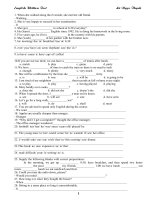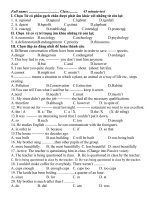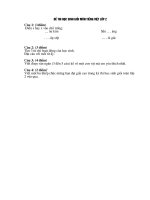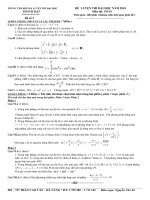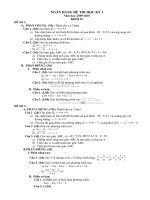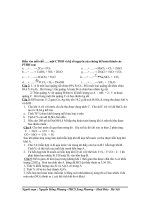DE THI SO 2 THPTQG
Bạn đang xem bản rút gọn của tài liệu. Xem và tải ngay bản đầy đủ của tài liệu tại đây (46.14 KB, 3 trang )
ĐỀ THI SỐ 2( Thời Gian Làm Bài 60 Phút)
Mark the letter A, B, C, or D on your answer sheet to indicate the word whose underlined part differs from the
other three in pronunciation in each of the following questions.
Question 1: A. get
B. gentle
C. give
D. game
Question 2: A. ancestor
B. ancientness C. angle
D. amoral
Mark the letter A, B, C, or D on your answer sheet to indicate the word that differs from the other three in the
position of primary stress in each of the following questions.
Question 3: A. register
B. regular
C. request
D. reference
Question 4: A. advantageous B. exchange
D. prediction
D. deliver
Mark the letter A, B, C, or D on your answer sheet to indicate the underlined part that needs correction in each of
the following questions.
Question 5: A deficient(A) of folic acid is rarely found(B) in humans because(C) the vitamin is contained in(D) a wide
variety of foods.
Question 6: The gopher digs(A) with the big strong claws of its(B) two front foot(C) and with its overhanging(D) front
teeth.
Question 7: An internationally famous ballerina(A), Maria Tallchief demonstrated(B) that the(C) quality of ballet in
North America could equal those(D) of the ballet in Europe.
Mark the letter A, B, C, or D on your answer sheet to indicate the correct answer to each of the following
questions.
Question 8:……………to his brother’s graduation party, George wouldn’t have met Mary.
A. Had he not gone
B. Hadn’t he gone
C. If he has not gone
D. If he shouldn’t have gone
Question 9: Since they aren’t answering the phone, they……………
A. Need have lef
B. Can’t have lef
C. Must have lef
D. Should have lef
Question 10: Mary: “Who wrote the poem?”
Peter: “It is said……………written by one of the Bronte sisters.”
A. To be
B. To being
C. To have been
D. To having been
Question 11: Nowadays children would prefer history……………in more practical ways.
A. To be taught
B. Teach
C. Be taught
D. To be teaching
Question 12: I’d sooner they……………deliver the new furniture tomorrow.
A. Mustn’t
B. Shouldn’t
C. Didn’t
D. wouldn’t
Question 13: Jane: “It’s going to rain.”
Mary: “……………”
A. I hope so
B. I don’t hope either
C. I don’t hope so
D. I hope not
Question 14: Throughout the animal kingdom, ……………bigger than the elephant.
A. Whale is not only the
B. only the whale is
C. Is the whale only
D. Only whale is the
Question 15: The fact……………money orders can usually be easily cashed has made them a popular form of payment.
A. Of
B. That
C. Is that
D. which is
Question 16: The first article of the United States Constitution gives Congress……………to pass laws.
A. The power
B. has the power
C. the power is D. of the power
Question 17: The sixth time he called me at night was the ……………
A. Lost cause
B. last straw
C. touch and go D. hot air
Question 18: Even if you are rich, you should save money for a……………day.
A. Windy
B. cloudy
C. snowy
D. rainy
Question 19: I have no idea how to……………this kind of business.
A. Make
B. turn
C. take
D. run
Question 20: Tom: “Do you know where Bard is?”
Marry:“ Strange……………sound, she is in South Africa.
A. May it
B. as it may
C. like it may
D. does it
Question 21: They seem to be……………to the criticism and just carried on as before.
A. Disinterested
B. sensitive
C. uncaring
D. indifferent
Mark the letter A, B, C, or D on your answer sheet to indicate the word(s) CLOSEST in meaning to the underlined
word in each of the following questions.
Question 22: Just drop me a line in order to know when you are coming.
A. Give me a ring
B. write to me
C. call me
D. drop in me
Question 23: Do you think that Mr. John is on the level?
A. Honest
B. talented
C. intelligent
D. dishonest
Mark the letter A, B, C, or D on your answer sheet to indicate the word(s) OPPOSITE in meaning to the underlined
word in each of the following questions.
Question 24: The International Organizations are going to be a temporary way in the country.
A. Permanent
B. guess
C. complicated D. soak
Question 25: Newspaper gossip had prejudiced her against him.
A. In side of
B. in favor of
C. in support
D. on favour for
Mark the letter A, B, C, or D on your answer sheet to indicate the sentence that is closest in meaning to each of the
following questions.
Question 26: When he met his long-lost brother, he was at a loss for words.
A. When he met his long-lost brother, he refused to say anything.
B. When he met his long-lost brother, he had nothing pleasant to say.
C. When he met his long-lost brother, he was puzzled about what to say.
D. When he met his long-lost brother, he had much to say.
Question 27: “You’re always making terrible mistakes”, said the teacher.
A. The teacher asked his students why they always made terrible mistakes.
B. The teacher realized that his students always made terrible mistakes.
C. The teacher complained about his students’ making terrible mistakes.
D. The teacher made his students not always make terrible mistakes.
Question 28: I didn’t know you are coming, so I didn’t wait for you.
A. If I had known you were coming, I would wait for you.
B. Were I to know you were coming I would wait for you.
C. Had I known you were coming, I would have waited for you.
D. If I knew you were coming, I would wait for you.
Mark the letter A, B, C, or D on your answer sheet to indicate the sentence that best combines each pair of
sentences in the following questions.
Question 29: The plan may be ingenious. It will never work in practice.
A. Ingenious as it may be, the plan will never work in practice.
B. Ingenious as may the plan, it will never work in practice.
C. The plan may be too ingenious to work in practice.
D. The plan is as impractical as it is ingenious.
Question 30: The student next to me kept chewing gum. That bothered me a lot.
A. The student next to me kept chewing gum, that bothered me a lot.
B. The student next to me kept chewing gum, which bothered me a lot
C. The student next to me kept chewing gum bothering me a lot
D. The student next to me kept chewing gum bothered me a lot.
Read the following passage and mark the letter A, B, C or D on your answer sheet to indicate the correct word or
phrase that best fits each of the numbered blanks from 31 to 35.
In the western customs shaking hands is the customary form of greeting, but in China a nod of the head or (31)slig
bow is sufficient. Hugging and kissing when greeting are uncommon. Business cards are ofen exchanged and yours
should be printed in your own language and in Chinese. Also, it is more respectful to present your card or a gif or
-any other article using(32) both hands. The Chinese are (33)ethui applauders. You may be greeted with group
clapping, even by small children. When a person is applauded in this practice it is the custom for that person to
return the applause or a "thank you." When walking in public places, direct eye(34) loo.. and staring is uncommon in
the larger cities, especially in those areas accustomed to foreign visitors.(35) Howe, in smaller communities, visitors
may be the subject of much curiosity and therefore you may notice some stares. Generally speaking, the Chinese are
not a touch-oriented society, especially true for visitors.
Question 31: A. small
B. bit
C. slight
D. light
Question 32: A. pair
B. couple
C. double
D. both
Question 33: A. enthusiast
Question 34: A. contact
Question 35: A. moreover
B. enthusiastic
B. look
C. stare
B. furthermore
C. enthusiasm
D. watch
C. however
D. enthusiastically
D. whatever
Read the following passage and mark the letter A, B, C or D on your answer sheet to indicate the correct answer to
each of the questions from 36 to 42
The Alaska pipeline starts at the frozen edge of the Arctic Ocean. It stretches southward across the largest and
northernmost state in the United States, ending at a remote ice-free seaport village nearly
800 miles from where it begins. It is massive in size and extremely complicated to operate.
The steel pipe crosses windswept plains and endless miles of delicate tundra that tops the frozen ground. It weaves
through crooked canyons, climbs sheer mountains, plunges over rocky crags, makes its way through thick forests, and
passes over or under hundreds of rivers and streams. The pipe is 4 feet in diameter, and up to 2 million barrels (or 84
million gallons) of crude oil can be pumped through it daily.
Resting on H-shaped steel racks called "bents," long sections of the pipeline follow a zigzag course high above the
frozen earth. Other long sections drop out of sight beneath spongy or rocky ground and return to the surface later on.
The pattern of the pipeline's up-and-down route is determined by the ofen harsh demands of the arctic and
subarctic climate, the tortuous lay of the land, and the varied compositions of soil, rock, or permafrost (permanently
frozen ground). A little more than half of the pipeline is elevated above the ground. The remainder is buried
anywhere from 3 to 12 feet, depending largely upon the type of terrain and the properties of the soil.
One of the largest in the world, the pipeline cost approximately $8 billion and is by far the biggest and most
expensive construction project ever undertaken by private industry. In fact, no single business could raise that much
money, so 8 major oil companies formed a consortium in order to share the costs. Each company controlled oil rights
to particular shares of land in the oil fields and paid into the pipeline-construction fund according to the size of its
holdings. Today, despite enormous problems of climate, supply shortages, equipment breakdowns, labor
disagreements, treacherous terrain, a certain amount of mismanagement, and even thef, the Alaska pipeline has
been completed and is operating.
Question 36: The passage primarily discusses the pipeline's
A. operating costs B. employees
C. consumers
D. construction
Question 37: The word "It" in line 4 refers to
A. pipeline
B. ocean
C. state
D. village
Question 38: According to the passage, 84 million gallons of oil can travel through the pipeline each ghfvg
A. day
B. week
C. month
D. year
Question 39:The author mentions all of the following as important in determining the pipeline's route EXCEPT the
hguuj
A. climate
B. lay of the land itself C. local vegetation
D. kind of soil and rock
Question 40: How many companies shared the costs of constructing the pipeline?
A. 3
B. 4
C. 8
D. 12
Question 41: The word "particular" in line 29 is closest in meaning to vuguh
A. Peculiar
B. specific
C. exceptional D. equal
Question 42: Which of the following determined what percentage of the construction costs each member of the
consortium would pay?
A. How much oil field land each company owned
B. How long each company had owned land in the oil fields
C. How many people worked for each company
D. How many oil wells were located on the company's land
